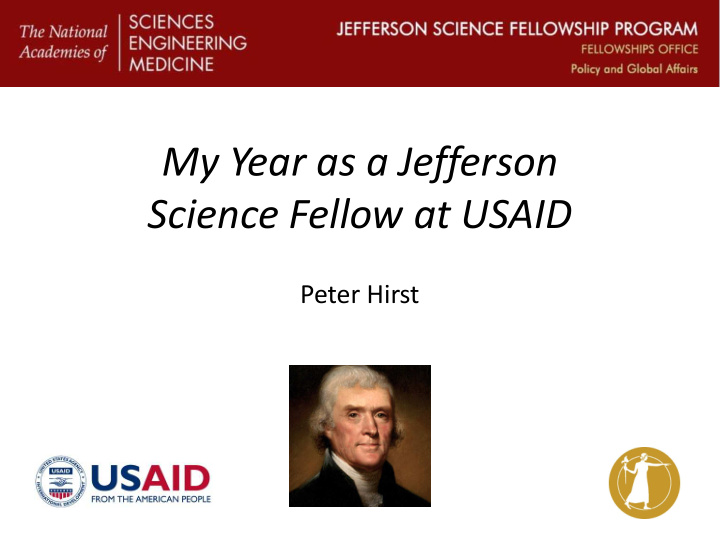



My Year as a Jefferson Science Fellow at USAID Peter Hirst
What is the purpose of JSF? JSF announced Oct 8, 2003 to establish: “ a new model for engaging the American academic science, technology, engineering, and medical communities in the formulation and implementation of U.S. foreign policy and international development programming .” Jefferson Science Fellows spend one year on assignment at the U.S. Department of State or USAID as science advisors on foreign policy/international development issues.
Who are the fellows? JSFs by discipline Biochemistry Mathematics Food Science Social science Agriculture/Forestry Computer Science Chemistry Physics Biology Geography/Env/Earth Medical/Vet Engineering 0 5 10 15 20 25 30 35 40 45
Why apply for JSF? • Gain first-hand understanding of government • Experience policy-making, intl. development practice • Have an impact on US foreign policy and implementation • Gain different perspective than academia • Develop networks within federal agencies
A few nuts and bolts • Must be a tenured scientist, technologist, engineer or physician • Must be U.S. citizen • Program is overseen by STASS • Salary paid by home institution • MOU signed between university and NAS • Living allowance paid through NAS • One year on-site assignment in Washington DC (may involve extended stays at US foreign embassies or missions) • Federal security clearance required • Purdue has had more JSFs than any other university
Selection based on • Stature, recognition , and experience in the national and international scientific or engineering community • Ability to rapidly and accurately understand scientific advancements both within and outside their discipline area and to effectively integrate this knowledge into U.S. Department of State and USAID policy discussions • Ability to articulate science and technology to the non- specialist/general public • Benefit of the fellowship to the applicant and the applicant's university • Related experience which may positively influence the success of the applicant in this fellowship
What did I actually do? • Very little within my area of academic expertise! • Youth development • Provided input on new starts, other programs • Grant panels / evaluating proposals • Employment framework – E3 • Attended many seminars – IPs, missions • Reviewed docs – internal white papers, talking points • Attended workshops / trainings (talent management is big)
USAID Organizational Chart ~4,000 employees
US Foreign Assistance, 2017 Foreign Aid Explorer https://explorer.usaid.gov
USAID Foreign Assistance, 2017
USAID Foreign Assistance, 2017 5 largest programs Largest ag. Program (# 38)
U.S. GOVERNMENT PARTNERS
USAID • Intelligent, engaged, hard-working, passionate people (but don’t expect an email response after 5:30 pm) • Highly collaborative • Well travelled – frequent TDY • Strong interaction between WDC and missions • High staff turnover – FSO, NGO • Geographically dispersed • Focused on programs that make a difference • Engaged with Congress • Career potential
A few reflections: • Purdue not particularly visible at USAID (apart from PICS bags) • People are very busy – many programs • Budgetary constraints • Minimal staff support • People are passionate • Research vs M&E • Apolitical JSF applications due Oct 31
Recommend
More recommend